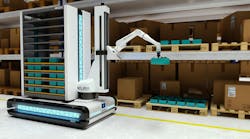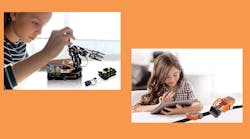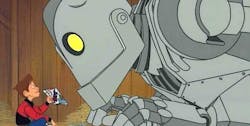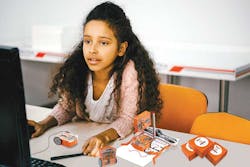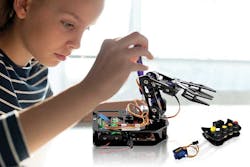Even if you don't have kids yourself, you've no doubt observed that young children compulsively watch the same shows and movies ad nauseam, though somehow, they never get sick of them, even though parents quickly do. In my female-dominated house, we went through the requisite Frozen phase and Trolls phase with my two youngest girls, buying the toys and clothes to go along with the obsession. Then earlier this year, I found The Iron Giant on Netflix and something wonderful happened: My daughters became equally crazy about the classic boy-and-his-robot tale. It's great because not only is the movie much more palatable my sensibilities (and lacks any musical numbers), but because of what this represents for their future.
My job is to write about that future—and automation plays a lead role. By the time my two-year-old starts school around 2022, the World Economic Forum predicts the robot revolution will create 133 million new jobs and displace 75 million. By 2025, machines will perform half of all current workplace tasks. Several new studies on the subject come out monthly, with varying numbers, but the prevailing theory is that the next generation of workers, and all those after, will need a firm grasp on Science, technology, Engineering and Math (STEM) principles to succeed. And my real job, after all, is to prepare my girls for success.
It's not going to be easy, as girls of even tech-savvy dads in 2018 inherit the "science-is-for-boys" stigma carried by their foremothers, which has contributed to the majority gender having grossly inadequate representation in high paying STEM fields. The U.S Department of Commerce says women with STEM jobs make a third more than women in non-STEM fields. This could widen even further as more jobs accrue a STEM component as they become more automated. The problem is that in 2013, females comprised only 12% of engineers and about a quarter of computer professionals.
My kids' interest—and constant reciting of The Iron Giant lines—indicate they are off to a good head start. The movie itself involves programming (and overcoming the protocols that make it a weapon), machine learning (the boy Hogarth teaching it to talk and act human), and even M2M communication (its scattered parts return to repair the robot). It's a subtle technical indoctrination into robotics that research shows should carry over to their formal education.
Of course, you can’t just turn on one movie and the problem is solved. Young minds are sponges, ready to sop up whatever you put in front of them. Now that they have as much interest in robots as they do Disney princesses, the next step is getting them to play with robots as much or more than their Elsa and Ariel dolls.
Earlier in the year, Learning Resources, based in a suburb north of Chicago, reached out to me and asked me to review their award-winning Botley the Coding Robot ($45-$80). It's designed for ages 5+, but the controller is simple and durable enough for them to operate.
Currently, Botley has an immaculate rating on learningresources.com, with 176 of 225 reviewers giving it 5 stars. After using it I can see why. It's colorful, has big eyes and beeps and boops like their other electronic toys, but instead of simply being another remote control toy, uses a remedial programming language based on plugging in directional commands (forward, back, left and right) and executing the order with the big green button. Botley comes with learning cards and you can upgrade with an obstacle course, though for now I just let them experiment with moving it around. The sturdy robot will roll on carpet, but hard surfaces work best. Now I'm teaching the 4-year-old more complicated commands, like what sequence will get the robot to go around the kitchen island, and what to press to make it return.
We also now have a Sharper Image RC Robot Arm I snagged for half off when Toys R Us went under. That is like terminator on tank treads compared to the docile Botley, with more complicated up/down controls for each tread and the four arm movements: the upper and lower arm, wrist, and claw. The 4-year-old loves it and can manipulate it fairly well to pick up a shoe (with some help) but the little one runs in terror of the louder, bigger, faster bot.
I thought this would be the right way to train my daughters, but every parent thinks they are right.
The Stats Don't Lie
A 2016 study of 7,750 children from K-8 found "early acquisition of knowledge about the world was correlated with later science success." Of children who start school with a lack of general knowledge, the data show 62% still struggle with science in third grade and 54% in eighth grade.
That's bad if you want your kid to have a higher chance at a decent job, but worse for America, which faces a skills gap of up to 2.4 million, jeopardizing $2.5 trillion in GDP over the next decade, according to Deloitte.
A paper published by the Joan Ganz Cooney Center summarizes the heart of the problem: "Today's preschoolers are tomorrow's inventors and problem solvers. In high-quality early learning environments, we can find these children playing with blocks and experimenting at the water table. Yet by the time they leave high school, a large percentage will have lost the confidence and motivation to engage in STEM subjects as adults (or worse, never had sustained opportunities to deepen their skills in the first place). This represents not only a loss for individual students; it is also a loss for our nation."
So how do parents keep that confidence high from early childhood to college?
"The earlier in life they are introduced to STEM, the more interested they are interested in those subjects later in life," says Eva Boker, president of HamiltonBuhl, a manufacturer of education tools and toys.
And more parents and educators are catching onto that. She says the company's 1½-yearold STEAM (the "A" is for arts) category has risen to its fifth largest (out of 18). Their Edison Educational Robot Kit ($59), compatible with LEGO blocks, synchs up with smart device to allow kids to code using a drag-and-drop method. As children get older, they can start learning Python. Edison can avoid obstacles, detect lines underneath it, sense lights and respond to sound commands.
"Whatever you can imagine you can build it out," Boker says. This includes turning it into a backhoe, a printer or a catapult.
Boker says that while these STEM toys have real benefits for appreciation of the sciences over something like Tickle Me Elmo, they are more entertaining as well.
"After a while it is no longer interesting when all it does is light up and make a sound and moves around," she says. "It is far more engaging when a child can think up something and make the tech do what they want it to do."
Edison, and the more advanced 4-axis STEAM Robo-Arm Kit ($189) are also effective in group settings, as they were designed for school use. Students can be assigned certain programming jobs. One can be responsible for lateral movement and another picking up a small object.
This collaborative environment is perfect for girls, says Mary Lennon, lead developer at HamiltonBuhl, which she thinks could reduce the negative stereotype that "it's not necessarily cool to be in robotics club or in science club."
When she went to high school in the 1990s, she was the only girl in many of her programming classes.
"That kind of environment isn’t necessarily inviting to young girls if they are in it alone, but if we can inspire more to explore STEAM fields, it could be easier for more women to stick with their interests and become industry leaders," Lennon says.
The Future of Manufacturing
There is no excuse for any school computer lab in 2018 to look like Mary Lennon's from the '90s. if it does, the blame should be shared by the school, parents and most of all, students. Ignorance is not a valid excuse when you have all the information in the world at your disposal, but spend all your time taking selfies.
But there might be hope for the future yet, as the gender trend seems to be shifting dramatically. Code.org reported that 29,000 females took the AP Computer Science exam last year, up from 2,600 in 2007 and a 135% jump over 2016. Minorities, also severely underrepresented, saw a 170% increase.
Computer skills are a part of the overall STEM skills set manufacturers will need to design and operate the automatons in factories and warehouses, but not the only ones necessary.
"STEM toys are a great way to spark interest in young girls to get them comfortable," says Bill Padnos, director of youth engagement for the National Tool and Machining Association. He oversees the National Robotics League, which partners schools with manufacturers to create fighting robots from scratch. "The next step is to engage girls in programs without kits where they need to design and fabricate their innovations. It is one thing to have girls learn coding and programming, it is another thing to have them make chips."
Microsoft research indicates that extracurricular STEM education like the NRL, which has 25% female participation, can be the final key to turning girls who like robots into women who will someday help lead the industry. Only half of the girls who perform STEM activities in the classroom feel empowered, while that jumps to 75% for girls who have hand-on activities and can connect theory to practical use.
"Are the girls being hands-on by machining parts and welding, or are they project managers?" Padnos asks. "I find that if we want for girls in STEM programs to want to work in industry, we need to allow them to be involved in all aspects of the manufacturing process."






